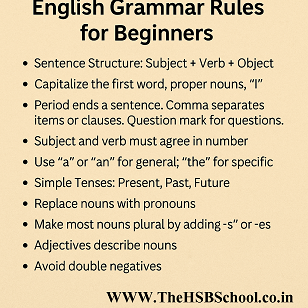Master these 10 must-know English grammar rules for beginners! Learn sentence structure, tenses, pronouns, and more with simple examples.

Table of Contents
Introduction
Learning grammar can feel intimidating—but it doesn’t have to be. Whether you’re starting from scratch or brushing up on the basics, these English Grammar Rules for Beginners will help you communicate more clearly and confidently.
Let’s simplify the fundamentals so you can start using English the right way!
10 Essential English Grammar Rules for Beginners
1. Sentence Structure
Every sentence needs three key elements: a subject, a verb, and sometimes an object.
✅ Correct: She (S) eats (V) an apple (O).
❌ Incorrect: Eats apple. (Missing subject)
2. Capitalization Rules
Capitalize:
- The first word in every sentence: The sun is shining.
- Proper nouns: India, Mary, Google
- The word “I”: My brother and I are going out.
3. Punctuation Basics
- Period (.) ends a sentence: I love music.
- Comma (,) separates items: We bought apples, bananas, and oranges.
- Question mark (?) for questions: Where are you going?
4. Subject-Verb Agreement
The verb must match the subject in number:
- Singular: He reads books.
- Plural: They read books.
5. Articles: A, An, The
- Use “a” before consonant sounds: a cat, a house
- Use “an” before vowel sounds: an apple, an hour
- Use “the” when referring to something specific: the moon, the Taj Mahal
6. Simple Tenses
Understanding basic tenses is key:
- Present: I eat breakfast.
- Past: I ate breakfast.
- Future: I will eat breakfast.
7. Pronouns
Pronouns help avoid repetition:
- Rahul is kind. He always helps others.
- Lisa lost her keys. She is looking for them.
8. Plural Nouns
- Most nouns: add -s/-es → car → cars, bush → bushes
- Irregular plurals: man → men, foot → feet
9. Adjectives
Adjectives describe nouns:
- a beautiful flower, an old building, a fast car
10. Avoid Double Negatives
Using two negatives in one sentence makes it confusing: ❌ I don’t want nothing.
✅ I don’t want anything.
Common Mistakes to Watch Out For
Its vs. It’s
- Its = possessive → The cat licked its paw.
- It’s = it is → It’s raining outside.
Your vs. You’re
- Your = possessive → Your phone is on the table.
- You’re = you are → You’re doing great!
Then vs. Than
- Then = time → First we ate, then we left.
- Than = comparison → She is taller than me.
Practice Exercise
Can you fix these common errors?
- He don’t like spinach. → He doesn’t like spinach.
- We goes to school. → We go to school.
Tips for Learning Grammar
- Read every day – Try books, news articles, or movie subtitles.
- Speak aloud – Practice using short, simple sentences.
- Use grammar apps – Tools like Duolingo or Grammarly can help.
Final Thought
Mastering these English Grammar Rules for Beginners lays the foundation for speaking and writing with confidence. Keep learning, keep practicing, and remember: making mistakes is part of the journey!
Stay curious—and let The HSB School guide you every step of the way.
Checkout our post on Conjunctions
